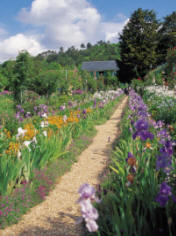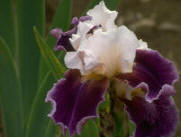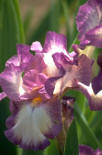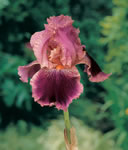|
How
To Grow Beautiful Iris Plants
in 8 Easy steps

A few important steps
if you are planning to
plant your first Iris Garden, and even some good suggestions
for growing healthier and more beautiful iris for
the seasoned gardener.
Iris is a hardy perennial flower grown for its large, showy
blooms held high above the long, narrow leaves.
|
You'll see iris
widely distributed throughout the north temperate
zone. Their habitats are considerably varied, ranging from
cold regions into the grassy slopes, meadow- lands, stream
banks and deserts of Europe, the Middle East and northern
Africa, Asia and across North America.
 Although iris are hardy plants that
thrive in many areas, following these 8 simple tips will make
yours stand out from those being grown by your neighbors. Although iris are hardy plants that
thrive in many areas, following these 8 simple tips will make
yours stand out from those being grown by your neighbors.
1. When to plant. Plant in July, August, and even September. If
your summers are hot and winters mild, start planting in
September and on into October.
2. Where? Select an area with at least a half day of full sun and
good soil drainage. Raised beds or slopes are good spots.
3. Preparing the Soil. Most garden soils will support the growth
of your iris plants. If you are uncertain about the quality of
your soil, have it analyzed. A pH of 6.8 is ideal.
Add coarse sand or humus if your soil is heavy. Your
garden shop will guide you in adjusting the pH (Acidity reading)
4. How Deep? The 'root' (or bulby thing) is called a rhizome.
Plant it just deep enough for its top to show and spread it's
roots out - facing down. In very hot climates, put about an inch
of soil over the top of the rhizome. Tamp the soil around the
rhizomes and water. Don't plant them any deeper than this.
5. How far apart? 12 to 24 inches apart is best in the long term.
Closer planting leads to more frequent thinning but is prettier
in the short term. You choice -
6. About watering - deep watering less often is better than
shallow watering too often. It depends upon your soil and your
climate. Don't over-water. Actually, established iris don't need
to be watered unless your climate is arid.
7.
Fertilizing - depends upon your soil. A light application
of bone meal, superphosphate and 6-10-10 in early spring and
again 3 or 4 weeks after blossoms have withered will bring good
future blooms and growth. Do not fertilize with high nitrogen
products.
8. Thinning the rhizomes - necessary to be done every few
(3 or 4)
years. If you wait too long between dividing the rhizomes, your
iris plants will become overcrowded leading to less desirable
blossoms and possible plant disease. Thin by dividing clumps of
rhizomes.
 Let your iris
rhizomes have full sunlight and warmth. Cut the flower stems off
close to the ground when the blossoms have withered. Remove any
brown or diseased leaves, but leave the healthy green leaves
undisturbed. Let your iris
rhizomes have full sunlight and warmth. Cut the flower stems off
close to the ground when the blossoms have withered. Remove any
brown or diseased leaves, but leave the healthy green leaves
undisturbed.
And all gardeners know that keeping their gardens free of weeds
and debris is just as much the fun part of this rewarding
pastime as is enjoying the beauty of your iris plants and blossoms.
Share
with your Gardening Friends if you Like This
|
|
 1.
The Iris Spinn Off,
(Iris x germanica 'Spinn Off') is a fragrant reblooming
bearded iris that has magenta colored flowers with a rose
margin around the flower petals. With a velvety texture and
beautiful sword-shaped foliage, it has a plant height of
32”. Spinn Off blooms in the spring and then again in the
fall. It prefers average, well-drained soil. Spinn Off
prefers full sun, but will tolerate a little afternoon
shade. It will make a great addition around pools, ponds and
water gardens, and for mass plantings. 1.
The Iris Spinn Off,
(Iris x germanica 'Spinn Off') is a fragrant reblooming
bearded iris that has magenta colored flowers with a rose
margin around the flower petals. With a velvety texture and
beautiful sword-shaped foliage, it has a plant height of
32”. Spinn Off blooms in the spring and then again in the
fall. It prefers average, well-drained soil. Spinn Off
prefers full sun, but will tolerate a little afternoon
shade. It will make a great addition around pools, ponds and
water gardens, and for mass plantings.
More Exciting Iris Selections at The Nature Hills Nursery
HERE
 2.
Visit the American Iris Society (AIS)
website.
You'll find it to be an informative and helpful resource
for all kinds of iris information, Regional activities,
photos, tips, and a lot more. 2.
Visit the American Iris Society (AIS)
website.
You'll find it to be an informative and helpful resource
for all kinds of iris information, Regional activities,
photos, tips, and a lot more.
The American Iris Society is a nonprofit institution
incorporated
February 2, 1927, in the County of Philadelphia, State of
Pennsylvania. By the terms of the Charter, the Corporation
has no stockholders and exists for the sole purpose of
promoting the culture and improvement of the Iris.
We are proud Members of the American Iris Society, from
Region 3
(#97362) |
To Top Landscaping Small
Gardens |
|
|
© RichardPresents.com All
Rights Reserved. Old School Bldg, RmD1, 230 Centre St, Langhorne, PA
19047 USA |